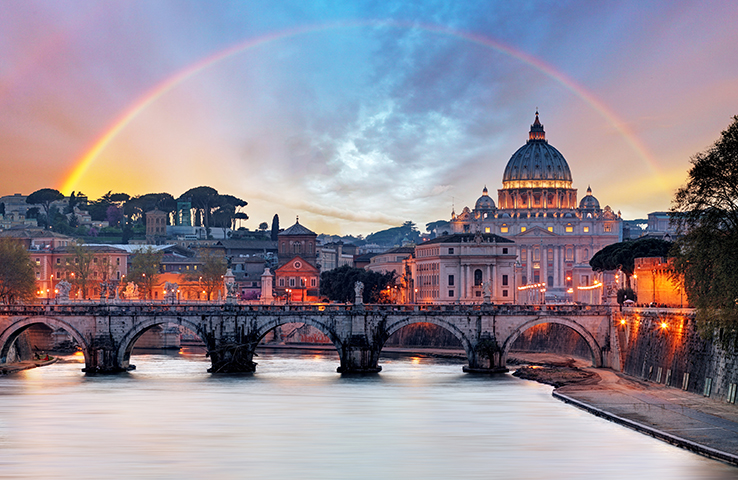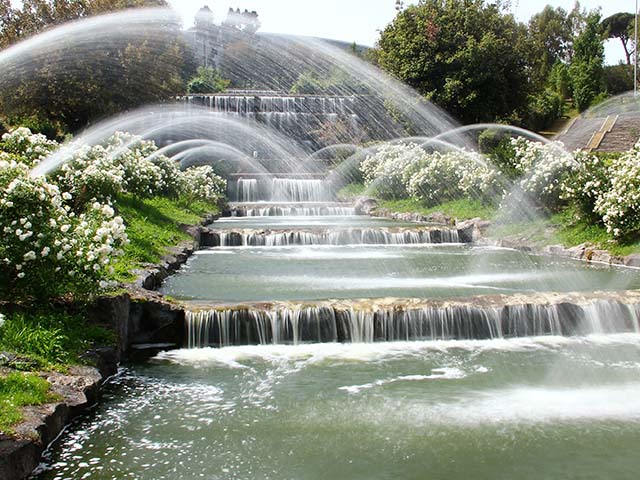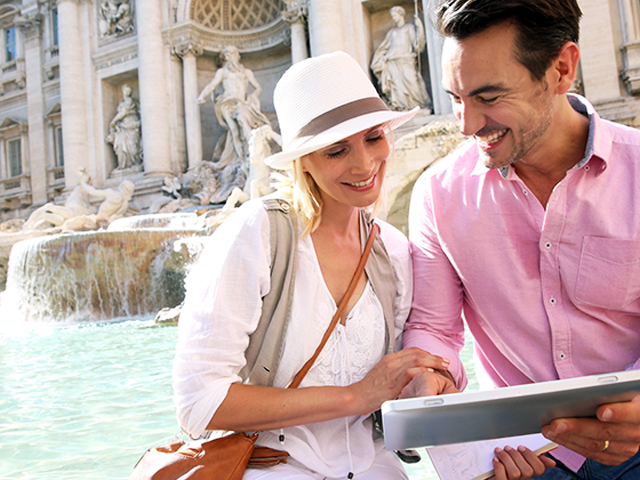Rome of the Romans: from Piazza del Popolo to Campo dei Fiori
Rome city center in 6-8 hours: an itinerary that aims right to the heart, exploring the most authentic part of the city.LENGTH

6-8 hours
Difficulty
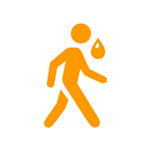
Medium
Budget

Low
Route stops
- Piazza del Popolo
Discovering Piazza del Popolo in Rome: how to get there, history, churches, the big obelisk and much more about one of the most famous squares in the world
- The Pantheon of Rome
Everything about the wonderful Pantheon of Rome: history, architecture, description, opening hours and useful information about how to get there.
- Visiting the Church of St. Louis of the French in Rome
Visiting the Church of St. Louis of the French in Rome: visiting hours, how to get there, ticket prices, Baroque art, Caravaggio, the Contarelli Chapel and other useful information
- Piazza Navona
Fom the Fountain of the four Rivers to the traditional Befana market: Piazza Navona is this and much more
- Campo dei Fiori Market
Campo dei Fiori in Rome: from folkloristic market in the heart of the historic centre to meeting point for nightlife.
Discovering Piazza del Popolo in Rome: how to get there, history, churches, the big obelisk and much more about one of the most famous squares in the world
Everything about the wonderful Pantheon of Rome: history, architecture, description, opening hours and useful information about how to get there.
Visiting the Church of St. Louis of the French in Rome: visiting hours, how to get there, ticket prices, Baroque art, Caravaggio, the Contarelli Chapel and other useful information
Fom the Fountain of the four Rivers to the traditional Befana market: Piazza Navona is this and much more
Campo dei Fiori in Rome: from folkloristic market in the heart of the historic centre to meeting point for nightlife.
With this itinerary we will discover some places in the city center of Rome, especially the ones loved by the Romans: squares, streets, churches and monuments of extraordinary value where you can feel the most authentic atmosphere of the city.
Are you ready then? Take up your camera, put on a pair of comfortable shoes and let's go!
GETTING AROUND ROME
VISIT ROME WHAT TO DO AND SEE
THE ITINERARY
1. Our departure point will be Piazza del Popolo, where you will get easily from the near Flaminio metro stop. Passing through the imposing Porta del Popolo, the Latin inscription by Bernini will welcome you saying "Felici faustoque ingressui MDCLV", that is "For a Happy and Propitious Entrance".
Most of the story of Rome passes through this square. From here, branch out the main shopping streets, the so-called trident fromed by Via del Babuino, Via del Corso and Via di Ripetta, but there are aldo important churches and monuments like the big Flaminio Obelisk, the Fountain of Neptune, the Church of Santa Maria del Popolo, and the towo "twin" churches of Santa Maria in Montesanto and Santa Maria dei Miracoli.
If you want to know the history of the square and find out what to see, read as well our in-depth article!

Piazza del Popolo
Let's leave Piazza del Popolo now for a pleasant walk along Via di Ripetta, historic street of the neighborhood Campo Marzio and part of the street group known as "Trident", along with Via del Babuino and Via del Corso. Rich of art workshops and small bars, pizzerias and restaurants, wine shops and tiny shops, Via di Ripetta will take you back in time!

The Porto di Ripetta in a suggestive old illustration
In early sixteenth century, the street was called Via Leonina, due to the restoration works comissioned by Pope Leon X. In 1704 the Porto di Ripetta was built, a small river port used to unload wood, wine and coal.
To distinguish it from the port of Ripa Grande in Trastevere, the port was called with the diminutive form "Ripetta" and following the decay of the area and the closing of the river port, the street took its name.
During your walk you will find monumenta and important buildings like the Accademia di Belle Arti in the horseshoe-shaped nineteenth-century building, the Museum of the Ara Pacis and the Church of Saint Roch.
If you are interested in visiting the Museum of the Ara Pacis, with the famous Altar devoted to Peace built by emperor Augustus in 9 BC, refer to the official site.
Now, continue always straight along the Tiber, leaving it on your right, until Via di Ripetta joins Via della Scrofa and at the junction with Via di Santa Giovanna d'Arco turn left in Largo Giuseppe Toniolo. Continue along Via del Pozzo delle Cornacchie and turn right in Via della Rosetta.
After few meters you will get to the second part of our tour: the Pantheon.
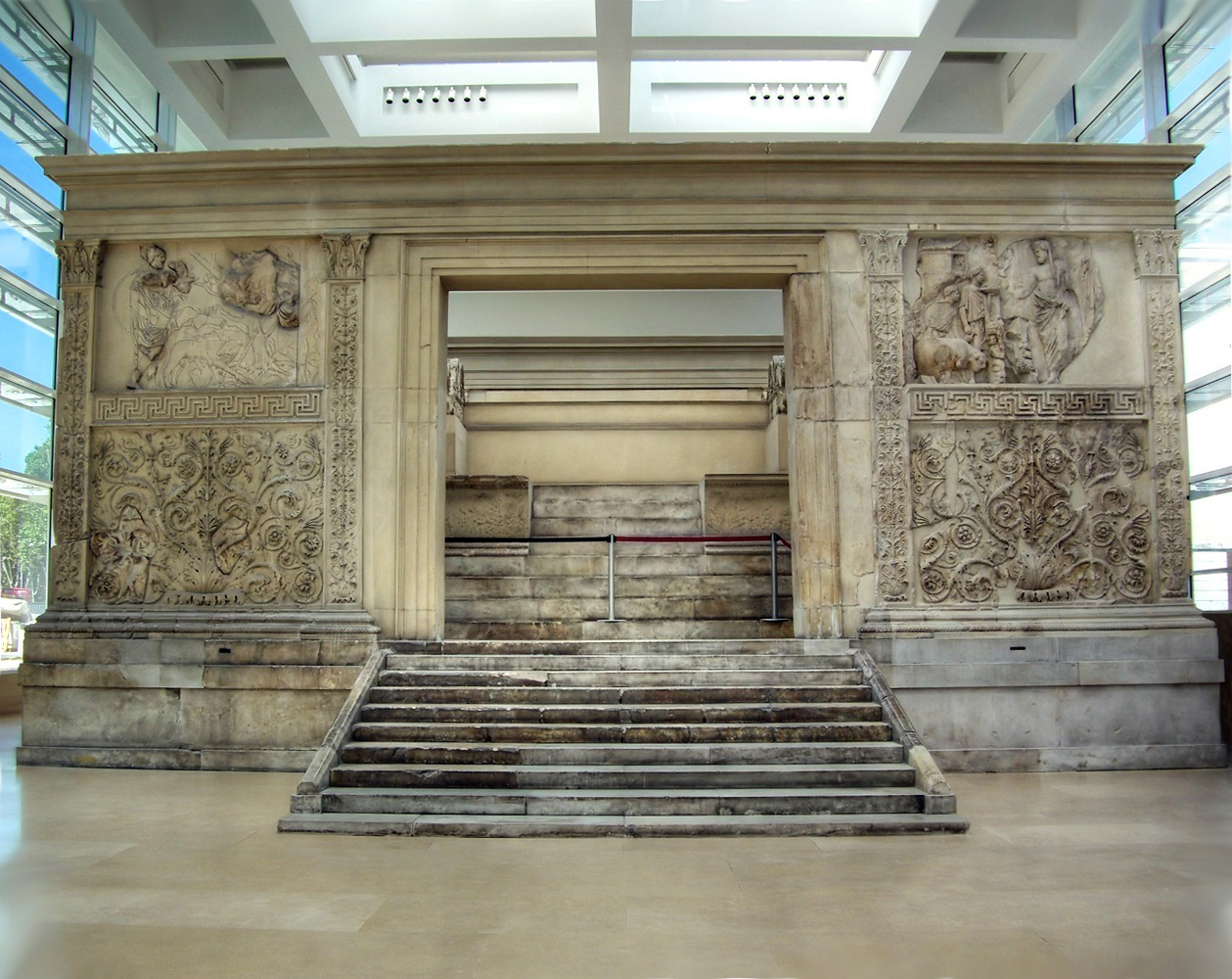
Ara Pacis - Rome
2. In Piazza della Rotonda, in addition to the fountain with the same name, there is an authentic architectural and engineering masterpiece waiting for you... the Pantheon! Among Rome's best preserved historic monuments, it has had great influence in all the Occidental architecture.
BOOK YOUR GUIDED TOUR TO THE PANTHEON

The Pantheon of Rome
The temple is formed by a circular cella covered by an hemispherical dome, preceded by a pronaos of Greek origin with 16 Corinthian columns that hold the tympanum. Once you have passed the giant main entrance, unfolds before your eyes an architectural wonder. All of a sudden you will find yourself in this enormous empty space that will make your head spin and will make you feel very little. So you need to feel in the presence of the gods!
The name comes, in fact, from the Greek words pan (all) and theon (god), and in its origins the Pantheon was a small temple devoted to all the gods.
If you want to find out more about the history, legend and many other curiosities about his stunning monument read our in-depth article.
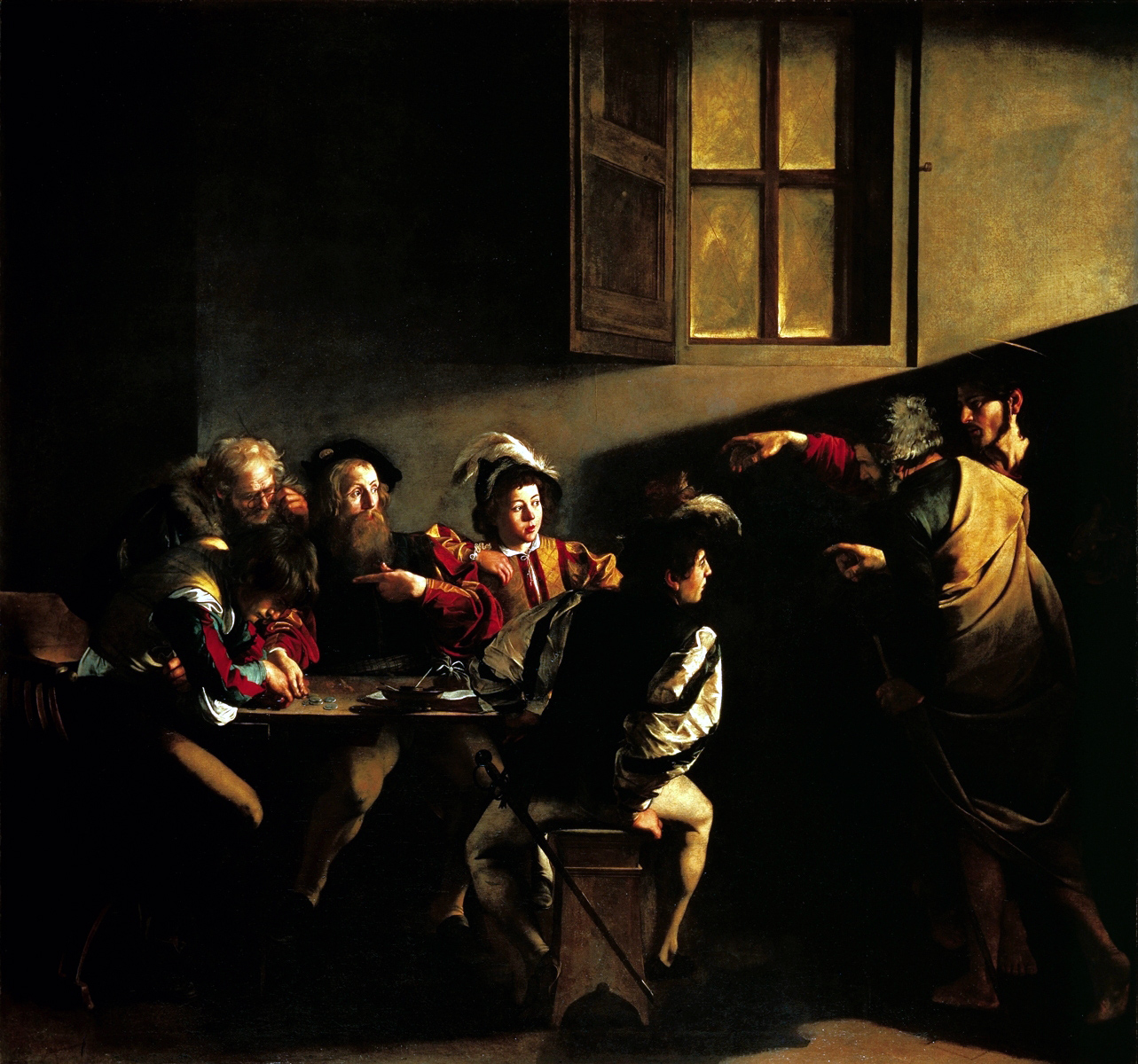
Caravaggio - The Calling of Saint Matthew
3. Now go back and from Piazza Della Rotonda enter in Via Giustiniani. At the junction with Via della Dogana Vecchia continue straight along Via del Salvatore. Stop here for a minute in front of the presence of the Church of Saint Louis of the French, an authentic puro pearl set in the city center.
The Church, wonderful by itself, keeps in its interior great masterpieces by Caravaggio, like the triptyque formed by The Martyrdom of Saint Matthew, The Inspiration of Saint Matthew and The Calling of Saint Matthew in addition to other frescoes by Domenichino. Admission is free... enter and you won't regret it!
When you finish having your nose looking up, leave the church and in the crossroads with Corso del Rinascimento you will also find Palazzo Madama, current home of the Senate of the Italian Republic.
4. Continue a bit further along the tiny Corsia Agonale and you will find yourself in Piazza Navona, one of the most beautiful and important squares of Rome.
Great meeting place, the square is always heaving with street artists, painters, tourists but also the Romans themselves. Despite the wide impact of tourism, many come here to sit on benches, to eat a gelato or merely to have a chat in the bars and pubs that make the square come to life. Piazza Navona can, in fact, be considered the most loved square by Romans.

Piazza Navona
There are unlimited things to do and to see in Piazza Navona! It's up to you to decide how long you want to stop by.
We advice you to spend some time visiting the beautiful Church of Sant'Agnese in Agone looking out onto the square, in front of the Fountain of the Four Rivers. Bear in mind that this two extraordinary monuments have been at the center of an intense rivalry between the authors: Bernini and Borromini. Looking at the fountain, do you spot something weird?
If you want to know about this funny anecdote and many other curiosities about Piazza Navona, read our in-depth article!
Before getting back to the road to get the last stop, take advantage to explore the surroundings Piazza Navona. This area is crammed with shops, restaurants, bars and ice-cream shops. If you visit it during Christmas time, you will find the traditional market, and you will see the square filled with carousels, coloured lights, stalls, toys and much more until the Epiphany, when the Befana, an old woman who delivers gifts to children, arrives.
5. Leave the square from Via della Cuccagna or Via di San Pantaleo and at the crossroads with Corso Vittorio Emanuele II enter Via dei Baullari. Walk lways straight and you will get to Campo de' Fiori.
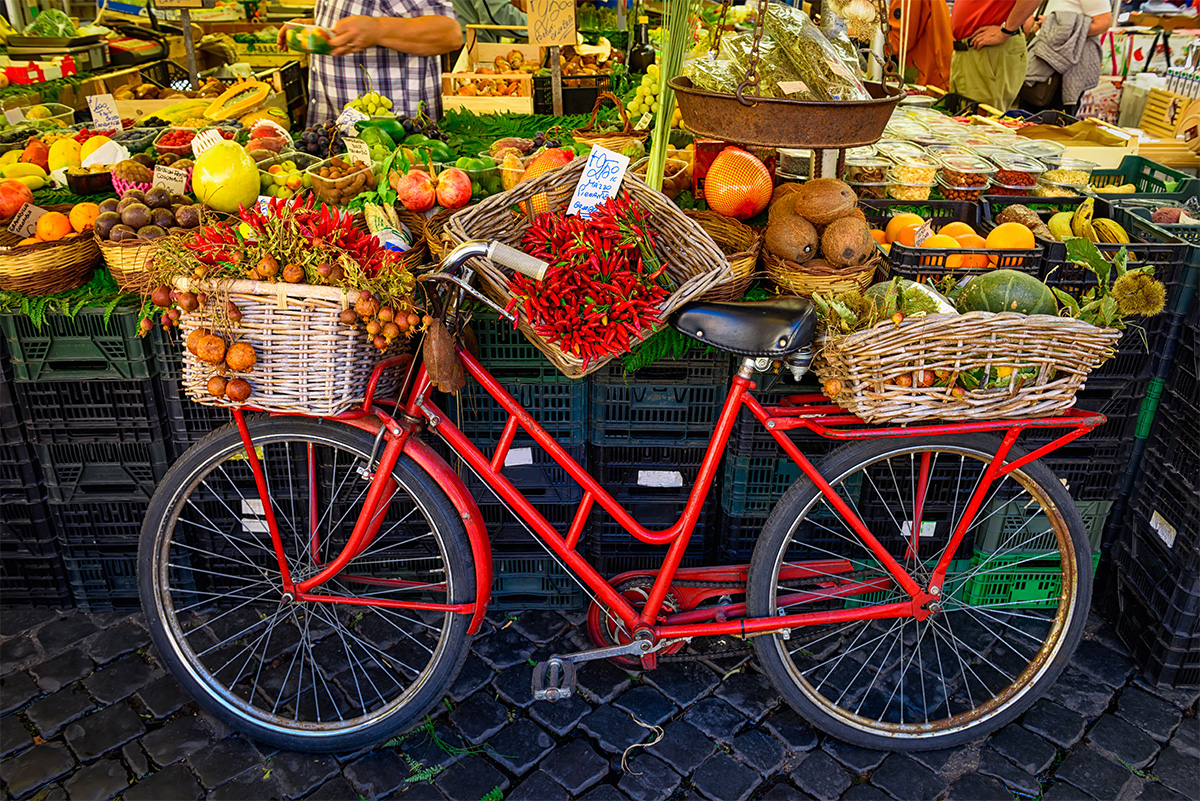
The Market of Campo dei Fiori
Campo dei Fiori is probably the oldest market of Rome. From 1869, every morning, except on Sunday, the square is heaving with a piazza is filled with colourful stalls selling fruit, vegetables, meat, poultry and fresh fish.
Among the specialities of the house, the unmissable Roman artichokes, and other vegetables like broccoli and spinach. The maket of Campo dei Fiori is a true feast for eyes and palate! To end with, in the surroundings you will also find food shops, bakeries and much more! Campo dei Fiori is really the right place to buy Roman specialities or to get some food provisions to do a nice picnic outdoor.
While being a historic and folkloristic market during the day, when night comes Campo dei Fiori becomes a meeting point for nightlife and young movida. Exploring the historic streets nearby, you will find bars, restaurants and artisan workshops that still today bring the name of the artisans who used to work tehre, like Via dei Baullari, Via dei Cappellari or Via dei Giubbonari.
If you want to find out more about the history of this square read here.
Our short journey discovering the most authentic Rome ends here! Hoping that you liked it, we leave you some useful tips about how to get to Rome's main train stations from Campo dei Fiori.
And as usual... enjoy your trip and see you soon!
- To get to Termini Station you can go back to Corso Vittorio Emanuele II, to the stop C.SO VITTORIO EMANUELE/NAVONA and take bus 64 towards Termini for 10 stops. Alternatively, from Corso Vittorio Emanuele II, you can also get by foot to Largo di Torre Argentina and take bus 40 for 6 stops.
- To get to Roma Ostiense Station, instead, you have to get by foot to Corso del Rinascimento (400 meters) and at the stop RINASCIMENTO tkae bus number 30 (LAURENTINA) for 7 stops.
- To get to Roma San Pietro Station, in Corso Vittorio Emanuele II go to stop C.SO VITTORIO EMANUELE/S. A. DELLA VALLE and get on the bus 64 (P.ZA STAZIONE S. PIETRO) for 8 stops.



 PORT MOBILITY CIVITAVECCHIA
PORT MOBILITY CIVITAVECCHIA










